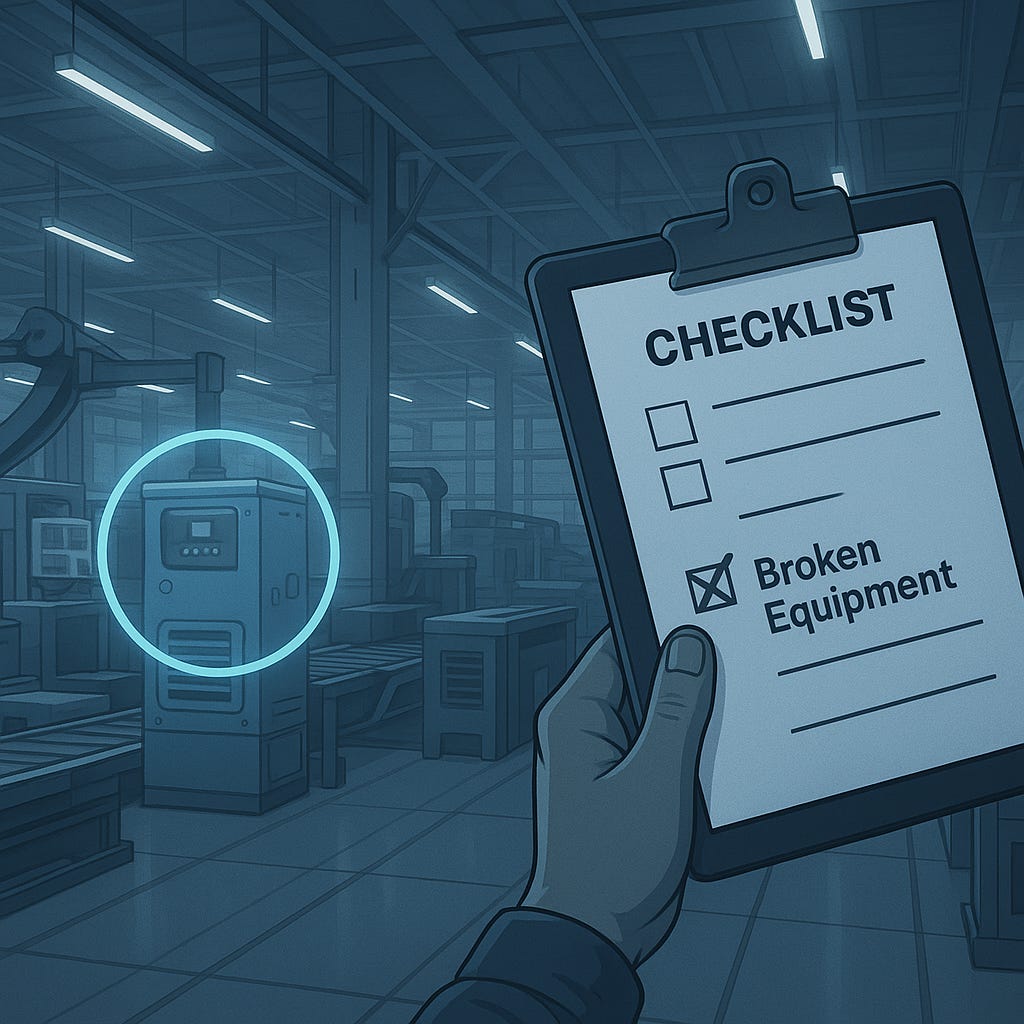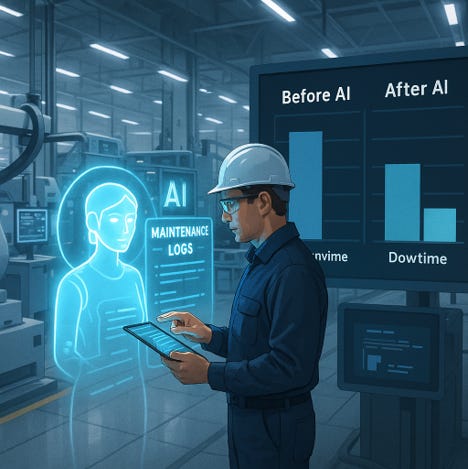Precision Over Routine
How Targeted Maintenance Transformed Downtime Into Performance
The Challenge
Every manufacturing floor runs on rhythm. When that rhythm breaks, production slows and frustration builds. The client knew the feeling. Crews walked the same inspection routes every day, checking every machine whether it needed it or not. It looked organized on paper but fell apart in practice.
Machines in perfect shape kept getting checked. The ones about to fail were often missed until they went down. Each breakdown meant lost production, overtime, and another scramble to get back online. Leadership didn’t want a new system for the sake of it. They wanted their people focused on what mattered most.
The data already existed. Years of SAP logs, vendor records from Grainger, and technician notes filled with experience were sitting unused. It was information without a plan. They needed a way to bring it together and make it useful.
The Method in Motion
We applied the AI Bridge Method™, a structure built to turn curiosity into capability. The first step was the AI Preparedness Assessment, which showed us the condition of their data and how their workflows fit together. The information was solid but scattered. The goal became clear: reduce downtime by helping technicians target equipment most likely to fail.
Designing the system was about keeping it simple. SAP data, vendor information, and sensor readings were connected into one clean pipeline. We focused on practicality and sustainability rather than layering on more software.
Building the System
We began with data cleanup. Old logs, parts orders, and handwritten notes were brought together into a single dataset. Once it was stable, we trained a local model through Ollama. Keeping it on-site gave us control and privacy.
We added vLLM to handle routing and scale. It kept the system quick enough for real-time updates without locking the client into proprietary tools.
Automation ran through n8n, pulling data, scheduling reports, and sending alerts directly to the team’s devices. LangChain managed context so the agents could share what they found. One watched performance logs, another tracked parts usage, and a third reviewed thermal images uploaded at the start of each shift.
Each morning, the technicians opened a variance report listing machines that showed unusual activity. The report suggested maintenance actions and included a short forecast of likely part failures. It wasn’t flashy, but it was clear and practical.
From Data to Daily Rhythm
Within a week, the floor felt calmer. Crews still walked their routes but began with the equipment flagged in the reports. The workday moved from routine to purpose.
Some early alerts were off, but each one was logged and fed back into the training cycle. Accuracy improved steadily. The team started to trust what the system was telling them. One tech joked that it “had a better nose for trouble than half the new hires,” and that was when we knew it had landed.
Continuous Refinement
Every alert required a response. Technicians confirmed whether it was right, wrong, or close. Those small inputs retrained the model over time. Each round made it sharper.
Once the system proved reliable, we added Abacus.AI Workflows for governance, scheduling, and audit tracking. That layer turned a working prototype into a sustainable platform that leadership could depend on.
The combination of Ollama, vLLM, n8n, LangChain, and Abacus.AI Workflows gave the client something balanced: open-source flexibility with enterprise control.
Results That Last
By the end of the first operational year, downtime had dropped by eighteen percent. The savings were estimated around $1.8 million. The bigger shift was how the work felt. Maintenance stopped being reactive. Crews focused on real issues, not repetitive checks.
At first, some expected the system to slow them down. Instead, it cleared the noise. Tasks became clearer, and confidence grew. AI stopped feeling like an outsider and started feeling like part of the crew.
Leadership saw the same change in the numbers that the floor felt in their workflow. This wasn’t an experiment. It was a working part of their operation.
Beyond the Pilot
The client kept going. The same structure now supports quality control and logistics. Different data, same foundation. The pattern works because the process is repeatable.
Closing Reflection
AI didn’t fix maintenance. The people did. It gave them better information at the moment they needed it. The mix of Ollama, vLLM, n8n, LangChain, and Abacus.AI Workflows turned years of untapped data into a trusted tool.
This project proved that structure and steady refinement beat hype every time. Predictive maintenance became part of daily life, not a buzzword.
That is what the AI Bridge Method™ does best. It builds systems that keep working long after the slides are closed and the meetings end.



